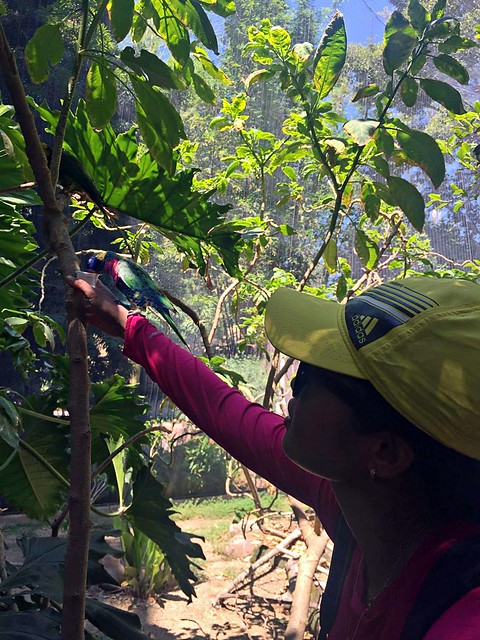Africa Doesn’t Even Look Like This
HOW TO VISIT SAN DIEGO’S SAFARI PARK? Today I’m sharing what it’s like to ride the most popular attraction of the Park – the Africa Tram. I also share tips on saving money in and outside the park.
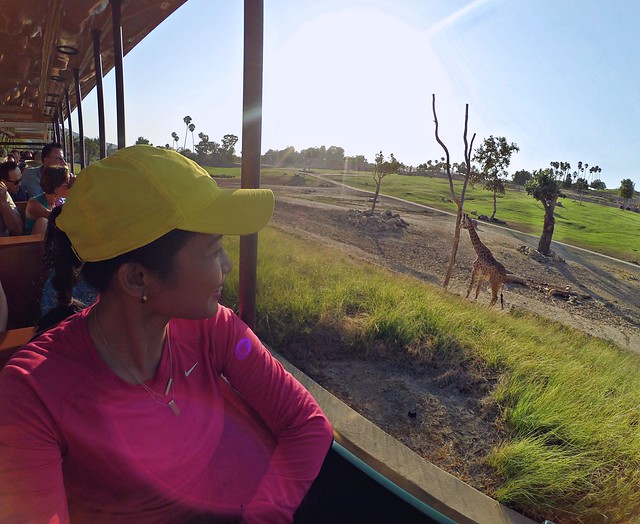
SELFIE WITH A RETICULATED GIRAFFE. Safari Park’s animals live in open outdoor areas and have room to roam in a way you feel nature had intended it
It’s just past 6 in the evening, and I’m taking the last excursion of the Africa Tram. This safari ride will guide me through the biggest field exhibit and one of the highlight features of San Diego Safari Park. Approximately 300,000 people ride it every year. If there are comparisons between the world-famous San Diego Zoo and the Safari Park, just imagine this: the entire Zoo can fit inside the Africa Tram’s field exhibit alone. Today I get to experience the most expensive and up-close encounter of a wildlife savanna through different animals of Africa.

THE AFRICA TRAM takes guests into a 30-minute guided tour where they can observe animals roam freely
On the front row bench where I’m sitting, a European-looking family is occupied not by the chance to see buffalos and cranes in relative wilderness, but with keeping their two kids under control. Mom, with her heavy infant bag, is holding on to dear baby girl while Dad is calming down a hyper 3-year old son. They both look at me narrowly wondering if I’m taking secret photos of their children using my action camera propped to a selfie stick.
I look to my left and see a Bongo with long horns and beautiful caramel skin. The Safari Park is home to 3,000 animals belonging to 300 different species. San Diego Zoo Global (who also owns San Diego Zoo, among others) is committed to conservation and animal care. As I shift my attention back to my surroundings, I realize it’s a glorious chance to see the Safari Park one last time. Bathed now in sunset gold, this is my second time around to try the ride today.
[READ: 7 Days in Oahu, Hawaii]
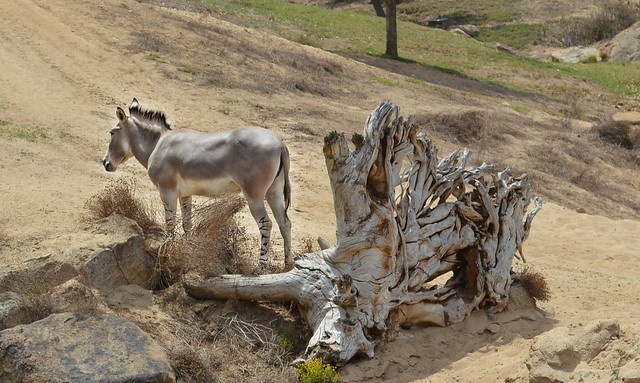
SMALL AND FAST. The most outstanding feature of the Somali Wild Ass are the horizontal stripes on its legs

DID YOU KNOW THAT the myth of the unicorns may have come from someone seeing a single-horned Scimitar Oryx?
San Diego Zoo, the most popular zoo in America, is located in downtown San Diego, California. Every year, when 3.2 million visitors see the Zoo, just 2 million people visit its sister, the San Diego Safari Park. Most don’t care to drive 35 miles north to San Pasqual Valley, Escondido where the Safari Park is located. Originally designated as a closed “breeding area” for the main Zoo, the owners of Safari Park realized that people will pay to see animals roam free in the open, so they opened the facility in 1972.
Even though I just spent half the day in this Park, I’ve decided I like it better than the main Zoo. I saw a cheetah, the world’s fastest land animal, run 300 meters in under 60 seconds. I fed colorful lorikeets with a $4/per cup special nectar. I even spotted a single-horned Scimitar oryx, which fulfilled my dreams of seeing a unicorn in real life. Upon entering, the first thing that greeted me was a well-arranged animal stage, lush plants and misters so magical and necessary it made me forget I was in the middle 100-degree Escondido summer heat wave.
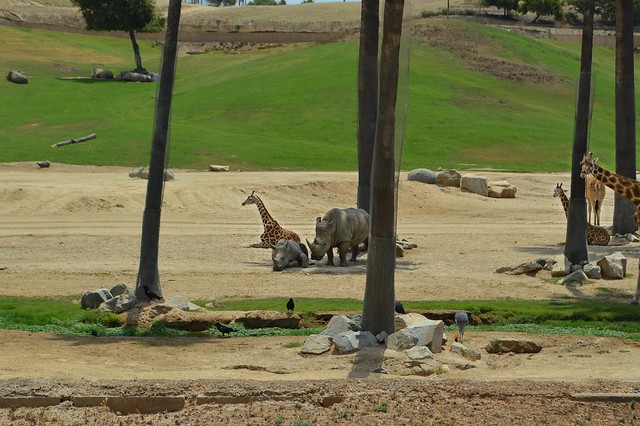
SOUTHERN WHITE rhinos are the second largest land animal, next to elephants. They are farmed for their highly-valuable horns, which some Asian cultures claim is a cure to many illnesses
I learned that along the driver’s side is ideal seating for the expansive views of animals and land. Only towards the end of the excursion will it really look like an actual African savanna. It’s one of the few times the driver takes a few seconds to stop giving me sweeping views of Safari Park’s 1,800 acres of protected wildlife and native species habitat. Here, giraffes and a few of the world’s last white rhinos walk side by side. Occasionally, I spot the $150/per person “Caravan Safari” tours that bring guests face-to-face with the animals. I see people feeding giraffes by hand and make a mental note of a great gift to any animal-loving friend. I’m envious of the people who can afford that on top of the $52 one-day pass.
The driver, also the guided narrator of the tram ride says, “Most of the animals you see in the park no longer exist in their natural habitats. They are under preservation all over the world. Even if you fly to Africa today, this isn’t what you see anymore.” One of the animals in the collection is the Grevy’s Zebra. They are originally from Somalia, whose history is marred by constant civil wars so dangerous tourists need to hire a small army for protection and where no physical US consulate exists. I may never step foot in Somalia, but I’m sure glad these Grevy’s Zebras are in good hands today.

FEVER TREES, one of the few trees where photosynthesis happen in the bark, are native to eastern and southern Africa. Notice their unique green barks
Within 30 minutes or so, the ride ends. It’s all too quick, but my companions seem ready to step off the tram already. Perhaps those children can finally get to leave the Safari Park, which is closing in a few minutes anyway. As everyone takes a quick right turn to the exit signs, I head solo the opposite direction. To the “African Loop” it says, another one mile featuring animals like Greater Flamingo, Southern White rhinoceros, and Abyssinnian Ground Hornbill. I’ll eventually see active Okapis, a family of ducks crossing a footbridge, hear hundreds of birds chirp and walk through a mystical collection of fever trees with green barks. I’m taking another few precious minutes to catch wildlife, to extend my alone time, hoping that Safari Park employees won’t catch me just yet.
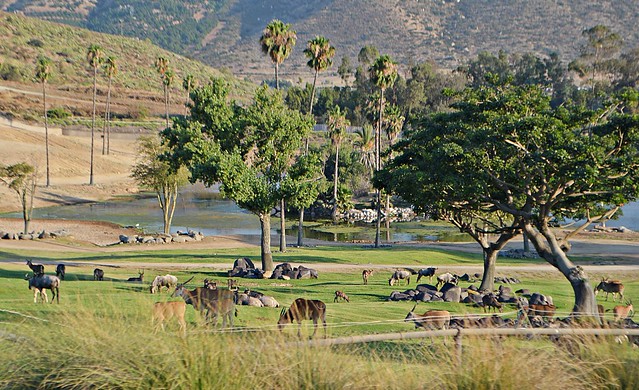
SAN DIEGO SAFARI PARK is located in San Pasqual Valley, Escondido. It’s about a 2-hour drive from Los Angeles Airport or an hour drive from San Diego Zoo
Tips on getting the most out of your trip to San Diego Safari Park
How To Save Money Inside The Safari Park
Food and drinks inside the Safari Park are overpriced, but you can bring your own food. Just rent a small locker near the entrance ($.75 cents). I also recommend buying a Safari Park souvenir cup ($12), which gets you unlimited drink refills throughout the day.
How To Find Cheap Tickets
One day rates for the San Diego Safari Park run about $52/adult. If you are planning to stay in San Diego for a few days, I recommend getting a San Diego Go Card. You can choose different time durations, but we did the 2-day version. We got to visit San Diego Zoo, all the museums in Balboa Park, and the San Diego Safari Park for just $100 per person.
—
About the Author
 Crystal Neri is a freelance writer who has worked across media platforms in places as diverse as US, Singapore, and Australia. She lives in Cebu City where she covers travel and entrepreneurship at crystalneri.com. Say Hi to her (@nericrystal) on Twitter and Instagram. Subscribe to her newsletter:
Crystal Neri is a freelance writer who has worked across media platforms in places as diverse as US, Singapore, and Australia. She lives in Cebu City where she covers travel and entrepreneurship at crystalneri.com. Say Hi to her (@nericrystal) on Twitter and Instagram. Subscribe to her newsletter:


